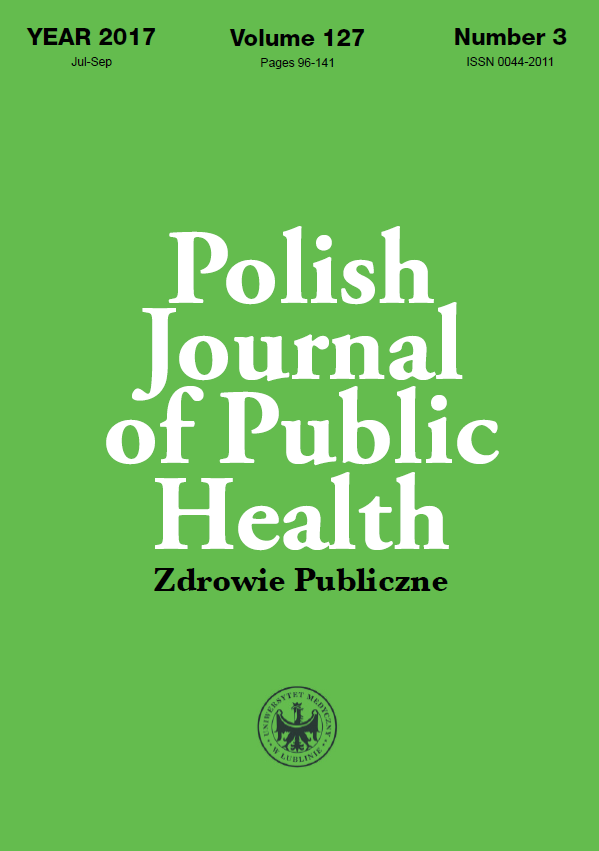Depression among oncological patients
DOI:
https://doi.org/10.1515/pjph-2017-0024Keywords:
depressive disorders, cancer, patientsAbstract
Introduction. The issue of depression in the context of cancer is a very important and complex problem. Suffering from depression and cancer at the same time concerns from 20% to 80% of the patients.
Aim. Assessment of depression occurrence among oncological patients depending on the profile of the disease.
Material and methods. The research group consisted of 63 oncological patients. Diagnostic poll method, survey technique was used. Occurrence and intensity level of depression symptoms were measured according to the Beck Depression Inventory (BDI) which was accompanied by the authorial questionnaire analyzing socio-demographic situation of the surveyed as well as the cancer profile i.e. type of cancer, ailments accompanying the disease and the frequency of their occurrence, undertaken therapies and their results.
Results. The analysis conducted with the help of BDI questionnaire presented the following results: more than half of the surveyed (54%, n=34) suffered from moderate depression and roughly 1/10 (n=7) of the surveyed suffered from severe depression. Only 1/3 (n=22) of the surveyed showed no signs of depression and complained only about low mood. Side effects of the treatment preventing patients from everyday functioning determined the occurrence of depression symptoms. Severity of cancer symptoms, duration of illness, time of diagnosis and number of attempts to fight the disease had no influence on the occurrence of depression symptoms.
Conclusions. Cancer influences every part of a patient’s life. Because of this, a holistic approach should be applied when treating such patients and that approach should be based on cooperation of doctors with clinical psychologists.
References
1. Dudek D, Siwek M. Współistnienie chorób somatycznych i depresji. Psychiatria. 2007;4(1):17-24.
2. Murawiec S. Depresja u osób z chorobą nowotworową. Rozpoznawanie i leczenie – aspekty praktyczne. OncoReview. 2012;2(3):201-8.
3. Mziray M, Żuralska R, Postrożny D, Domagała P. Poczucie depresji, lęku i bólu a style radzenia sobie w sytuacji trudnej u pacjentów z chorobą nowotworową. Przeds Zarz. 2014;XV(12):7-18.
4. Pasquini M, Biondi M. Depression in cancer patients: critical review. Clin Pract Epidemiol Ment Health. 2007;3(2):1-9.
5. de Walden-Gałuszko K, Majkowicz M, Trzebiatowska I. Najczęstsze problemy psychiatryczne w ambulatoryjnej praktyce onkologicznej. Psychoonkol. 1998;2:21-6.
6. Massie MJ. Prevalence of depression in patients with cancer. J Nat Cancer Inst Monogr. 2004;32:57-71.
7. de Walden-Gałuszko K. Psychoonkologia w praktyce klinicznej. Warszawa: PZWL; 2011.
8. Sobieralska-Michalak K, Kowalska J, Tudorowska M. Rodzaj zabiegu, a lęk, depresja, przystosowanie do choroby u kobiet z rozpoznanym rakiem piersi. Pol Forum Psychol. 2016;21(3):432-46.
9. Guglas N, Mackiewicz J, Pawlik P, Cichy W. Aspekty psychologiczne raka piersi u kobiet w okresie menopauzy. Prz Menopauz. 2007;1:19-22.
10. Kieszkowska-Grudny A. Dystres i depresja u chorych na nowotwory – diagnostyka i leczenie. OncoReview. 2012;2(4):246-52.
11. Dębski R, Kulik R. Rozpoznanie i leczenie depresji towarzyszącej nowotworom narządu rodnego. Ginekolog jako lekarz „pierwszego” kontaktu. Wektory Ginekologii. 2004;1:3-9.
12. Onitilo AA, Nietert PJ, Egede LE. Effect of depression on all-cause mortality in adults with cancer and differential effects by cancer site. Gen Hosp Psychiatr. 2006;28:396-402.
13. Kissane DW, Wein S, Love A, et al. The Demoralization Scale: a report of its development and preliminary validation. J Palliat Care. 2004;20:269-76.
14. Zawadzki B, Popiel A, Pragłowska E. Charakterystyka psychometryczna polskiej adaptacji Kwestionariusza Depresji BDI-II Aarona T. Becka. Psychol Etol Genet. 2009;19:71-95.
15. Zając T. Struktura agresji i kontrola emocji u osób z rozpoznaniem depresji. Psychiatr Psychoter. 2014;10(4):16-29.
16. Kurowska K, Dahms S, Głowacka M, Haor B. Poczucie koherencji a depresyjność u osób z chorobą nowotworową. Psychogeriatr Pol. 2010;7(3):91-8.
17. Cuneo KM, Schiaffino KM. Adolescent self-perceptions of adjustment to childhood arthritis: The influence of disease activity, family resource, and parent adjustment. J Adolescent Health. 2002;31:363-71.
18. Stankiewicz A, Radziwiłłowicz W, Bidzan M. Związek cech osobowości, depresyjności i lęku z przebiegiem leczenia kobiet z nowotworem piersi. Psychoonkol. 2011;2:48-54.
19. de Walden-Gałuszko K, Majkowicz M, Zdun-Ryżewska A. Zaburzenia przystosowania do choroby nowotworowej – trudności diagnostyczne zespołów depresyjnych. Psychoonkol. 2013;1:10-5.
20. Ng CG, Mohamed S, Kaur K, et al. Perceived distress and its association with depression and anxiety in breast cancer patients. PLoS One. 2017;12(3): 0172975.
21. Osmańska M, Borkowska A, Makarewicz R. Ocena jakości życia, nasilenia cech lęku i depresji u pacjentów ze złośliwym zarodkowym nowotworem jądra w trakcie chemioterapii i po zakończonym leczeniu onkologicznym. Psychiatr Pol. 2010;XLIV(4):543-56.
22. Frączak P. Wybrane aspekty jakości życia u chorych leczonych z powodu złośliwych nowotworów w obrębie części twarzowej czaszki. Ann Acad Med Stetin. 2008;54(3):69-76.
23. Kosowicz M, Kulpa M, Ziętalewicz U, et al. Umiejscowienie kontroli zdrowia a lęk i depresja u pacjentów z chorobą nowotworową tkanek miękkich i kości. Med Paliat. 2014;3:165-9.
24. Stępień R, Wrońska I. Lęk i depresja jako emocjonalne uwarunkowania możliwości funkcjonalnych kobiet po radykalnym leczeniu raka piersi. Stud Med. 2008;10:31-5.
25. Goudarzian AH, Bagheri Nesami M, Zamani F, et al. Relationship between Depression and Self-care in Iranian Patients with Cancer. Asian Pac J Cancer Prev. 2017;18(1):101-6.
Downloads
Published
Issue
Section
License
Copyright (c) 2018 Polish Journal of Public Health

This work is licensed under a Creative Commons Attribution-NonCommercial-NoDerivatives 3.0 Unported License.


